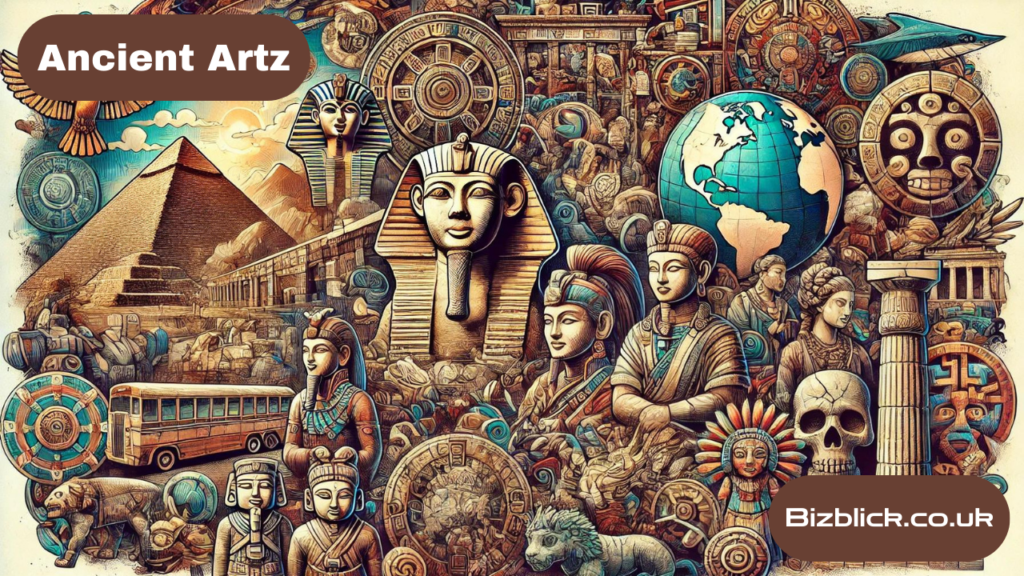What is Ancient Artz?
“Ancient Artz” refers to the diverse and multifaceted forms of art that were created by early human civilizations across different parts of the world. From the vibrant cave paintings of prehistoric times to the monumental sculptures of the Egyptians, Greeks, and Romans, ancient art encompasses a vast array of artistic expressions that reflect the cultural, spiritual, and social fabric of ancient societies. These artworks provide invaluable insights into our ancestors’ beliefs, rituals, and daily lives and continue to influence contemporary art and culture.
The Origins of Ancient Artz: A Journey Through Time
Ancient art can be traced back to prehistoric times when early humans expressed themselves through simple drawings and carvings on cave walls. These early art forms, such as the famous cave paintings in Lascaux, France, and Altamira, Spain, depict animals, hunting scenes, and abstract symbols, revealing the connection between ancient humans and their natural surroundings. As societies developed, so did their artistic expressions, leading to more sophisticated art forms in various regions, such as Mesopotamia, Egypt, Greece, India, China, and Mesoamerica.
The Artistic Achievements of Early Civilizations
Mesopotamian and Egyptian Art: Power and Divinity
The ancient civilizations of Mesopotamia and Egypt were among the earliest to develop complex forms of artistic expression. Mesopotamian art, particularly from the Babylonian and Assyrian periods, is characterized by its detailed reliefs depicting royal hunts, military campaigns, and mythological scenes. The Ishtar Gate of Babylon, adorned with glazed brick reliefs of dragons and bulls, exemplifies the grandeur and authority of the Babylonian empire.
Egyptian art, on the other hand, is deeply intertwined with religion and the afterlife. The art from this period includes elaborate tomb paintings, statues, and burial goods created for the pharaohs and nobility. Iconic works like the Great Sphinx of Giza, the bust of Queen Nefertiti, and the treasures of Tutankhamun’s tomb showcase the extraordinary skill of Egyptian artisans and provide valuable insights into the religious beliefs, societal structure, and daily life of ancient Egypt.
Greek and Roman Art: The Foundations of Western Aesthetics
Greek art is renowned for emphasizing naturalism and the pursuit of ideal beauty. Greek artists developed techniques such as contrapposto, which introduced a sense of movement and realism to sculpture. They also explored the human form in detail, striving to achieve perfect proportions. The Parthenon, with its harmonious architecture and sculptural decorations, stands as a testament to the artistic achievements of ancient Greece.
Roman art, heavily influenced by Greek precedents, focused on realism and the glorification of the empire. Roman artists excelled in portraiture, capturing the likenesses of emperors and notable figures with remarkable accuracy. Their architectural innovations, such as the use of arches and the development of concrete, led to the creation of iconic structures like the Colosseum and the Pantheon, which continue to inspire modern architecture.
Asian Artz: A Harmonious Blend of Spirituality and Nature
Indian and Chinese Art: Spirituality in Every Stroke
In ancient India, art was primarily connected to religious and spiritual themes, reflecting the philosophies of Hinduism, Buddhism, and Jainism. The intricate carvings on the stupa at Sanchi and the rock-cut temples of Ellora are prime examples of Indian art that embody these spiritual beliefs and practices. These works not only demonstrate the technical skill of Indian artisans but also convey profound philosophical and religious ideas.
Chinese art, with its roots in the Shang Dynasty, focuses on nature, harmony, and balance. Early Chinese artists mastered pottery, jade carving, and bronze casting techniques, creating both functional and aesthetically pleasing works. The Terracotta Army, created during the Qin Dynasty, is a monumental example of Chinese art that illustrates the power and organization of the ancient Chinese state.
Mesoamerican and South American Artz: Rituals and Cosmology
Ancient art in Mesoamerica and South America was deeply intertwined with religious beliefs and cosmology. The Mayans, for example, produced a rich artistic tradition that included intricate carvings, murals, and ceramics. Their art was closely tied to their religious beliefs, depicting gods, rituals, and celestial events. Notable examples, such as the Bonampak murals and Palenque sculptures, reveal the sophistication and spiritual depth of Mayan art.
The Inca civilization, known for its advanced engineering and architecture, also produced remarkable works of art, particularly in stone. The precision of Incan stone masonry is evident in structures like Machu Picchu and the fortress of Sacsayhuamán. Incan art often featured motifs of animals and deities, reflecting the civilization’s reverence for nature and the divine.
The Enduring Legacy of Ancient Artz
Ancient art continues to impact modern art, design, and architecture profoundly. The principles of balance, proportion, and naturalism developed by ancient artists are still taught in art schools today. Many modern artists draw inspiration from ancient motifs, techniques, and themes, reinterpreting them in contemporary contexts. The legacy of ancient art bridges the past and the present, reminding us of our ancestors’ creativity, innovation, and cultural richness.
The Importance of Preserving Ancient Artz
Preserving ancient art is crucial for maintaining our cultural heritage and understanding our shared history. These artworks provide a unique glimpse into ancient societies’ values, beliefs, and practices, enriching our knowledge and appreciation of the human experience. As globalization and modernization continue to transform the world, efforts to protect and preserve ancient art become ever more important, ensuring that future generations can continue to learn from and be inspired by these remarkable creations.
Conclusion: The Significance of Ancient Artz
Ancient artz, with its diverse forms and profound meanings, is a testament to the creativity and resilience of early human civilizations. From the symbolic cave paintings of prehistoric times to the grand monuments of ancient empires, these artworks tell stories that have shaped human history and culture. As we continue to explore and study these ancient masterpieces, we gain a deeper understanding of our roots and the enduring power of human expression.
